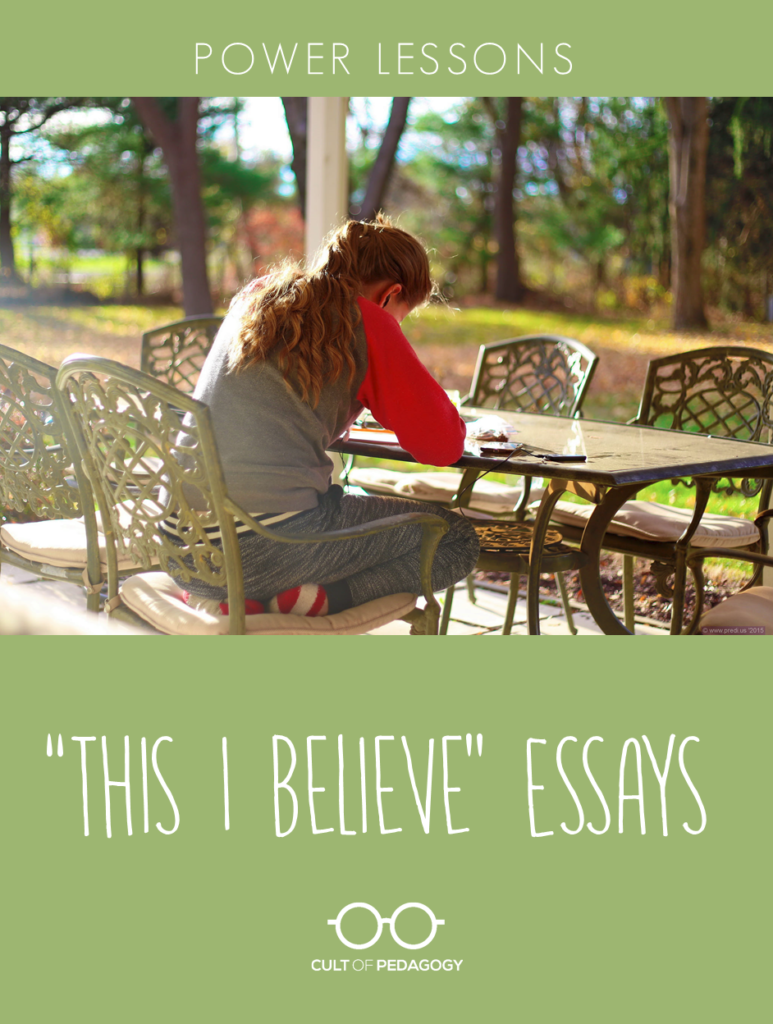
“Doing homework” by Predi is licensed under CC BY-ND 2.0
In this power lesson shared by high school English teacher Cynthia Ruiz, students write their own personal statements of belief. The essay pushes students to write about something that matters to them and helps them get to know each other on a deeper level.
I used to assign a “Letter to the Teacher” at the beginning of every year to get a snapshot of how a student writes while simultaneously learning background information. Being completely honest, this assignment is also an easy way to get the first few back-to-school days started when a 90-minute class period feels like 900 minutes, because everyone is typically on their best behavior and not talking much. Although I enjoy reading the letters, the assignment doesn’t lend itself to revising and is written only for a specific, one-person audience.
I know building relationships with students is important and a way to get to know them is through their writing, so I did some research to see what other teachers were trying. I came across the “This I Believe” site and immediately liked the concept better than an introduction letter for a teacher.
Assignment Guidelines
The first time I assigned a “This I Believe” essay was in the fall of 2014, during the second week of school. I planned it as a year-long endeavor, something we could work on as a distraction from other essays required to prepare for state testing. This past year, I did not assign it until late April; it would be our last major writing task. I wanted to give everyone plenty of time to write but held them to a firm deadline of having four weeks to work.
This time, I crafted my writing guidelines according to those posted on the NPR site that hosts hundreds of This I Believe essays from around the world. My rubric still has some typical writing conventions, but overall I think it focuses more on student voice than structure. I made it clear that students had a lot of choice regarding both content and format. The biggest restriction came directly from the This I Believe site: a 500-600 word limit. I know a lot of writing teachers are divided when it comes to word count, but I figured it was still better than giving a specific number of required paragraphs and sentences.
One other requirement was that students use at least three “vocabulary devices.” This may seem like a restriction, but it actually supported student voice. Over the spring semester, we spent a lot of time reviewing both rhetorical and literary devices (anaphora, hypothetical questions, simile) and I told students to focus on the devices they genuinely felt comfortable using.
Helping Students Choose a Topic
Because the rubric leaves room for a lot of choice, I encouraged students to visit the featured essays site and not only read, but listen to real examples. I wanted them to see that this wasn’t just another run-of-the-mill assignment, that what they believe is important and writing is just one way to share those beliefs. I also made it a point to tell them our end goal was to share this essay with their entire class by way of a gallery walk.
After giving students time to explore the site, I had them “rush write” in their notebooks to see what immediate ideas they captured to help start the brainstorming process. Here’s the prompt I used:
This I Believe
For 2 minutes:
List words or ideas that you think about when you think of YOUR LIFE.
(Can be feelings, symbols, names, events, etc.)
After students generated this list, I asked them to consider what they wanted to write about and share with others. I wanted them to imagine a larger audience and think outside of meeting my expectations.
For some, deciding what to write about was easy and they began drafting immediately. However, the majority of students struggled not so much with what they believe, but how to write about it. Even though they appreciated having so much choice, they still needed some direction to get started.
We continued the listing strategy by focusing on “most memorables”: most memorable events in life so far, most memorable stuffed animal, most memorable friends, family experiences, life lessons learned, and so on. I asked them to focus on why they remember what they remember, and whether or not it impacts any of their beliefs. One student remembered a saying his grandmother always told him that still provides comfort as he’s gotten older. Another focused on her family not having a big house when they first moved to America and how she’s learned to be satisfied with opportunities instead of possessions. While this strategy helped a lot of light bulbs go off, it didn’t work for everyone.
Another strategy I tried was using involved sentence stems: I know I am the way I am today because______. I know I think about things the way I do because _______. I think most people would describe me as ______. I emphasized that these phrases did not have to be included in their final products, but should help generate ideas. I talked with a few frustrated students about this strategy and they told me it made them realize they’ve never really had to think about themselves in this way, but ultimately, it gave them direction for their essays.
Drafting and Revising
Because of block scheduling, I gave students about a week and a half to complete a working draft, which required having at least two paragraphs of their essay done. I only gave a portion of two to three class periods to actually write in class; students were expected to write on their own time.
On the day drafts were due, I set aside class time for revision. I asked students to refer to the rubric and focus on voice and vocabulary strategies. Questions I told them to consider were: Does this sound like me? Do I talk like this to my friends or family? I gave students the option of reviewing their own essays or partnering up with someone to peer edit. Again, this was the end of the year, so we had already established a pretty firm community of trust in class. I don’t know if peer editing would have been as easy had I done the assignment early in the year.
Overall, draft day didn’t feel like the usual “revising and editing” days we’ve had with other essays. Students were very concerned with whether or not they were making sense, if they should add more, or if they were being too repetitive, rather than only being concerned about capitalization, spelling, and grammatical errors.
Sharing the Finished Essays
The culmination of this assignment was when the essays were shared in a gallery walk. The gallery walk is my answer to having students write for a larger audience, and it really helps this essay become about what students have to say instead of just another grade. I can’t count how many times I have returned tediously graded essays only to have a kid immediately walk over to the recycling bin and trash it! Sure he read the comments and suggestions I made, or saw the cute smiley face I left by an excellent word choice, but it didn’t mean much to him because the paper is graded and finished, and he is now done thinking about it. With a gallery walk, not only are students thinking about what they wrote, but they have the opportunity to think about what their classmates wrote as well.
I printed each essay without any names, and made sure any identifying statements were revised. However, there were quite a few students who said they were proud of what they wrote and had no problem if others knew which essay belonged to them. Because not every student turned in a final copy, I printed additional copies of some completed essays to ensure every student had something to read during our gallery walk, instead of drawing attention to the two or three students who did not finish the assignment.
I placed the essays on different tables throughout the room and allowed students to move around as needed; some chose to stand and read an essay, others opted to sit, while others sprawled out on the floor to read. I played soft music and asked that the room volume stay quiet enough to be able to hear the music at all times. I didn’t mind if students were sharing and discussing, and I really wish I recorded the various conversations and comments I overheard that day: “Wow! Did you read this one yet?” “Man. Who wrote this? I might cry. Good tears, though.” “This one is life, Ms. Ruiz.”
I provided a pad of post-its near each essay and told students to leave POSITIVE feedback for each other. I provided sentence stems to help:
Something I liked…
Something I can relate to/agree with…
Something that surprised me…
Something I want to know more about…
I really think…
I periodically checked to make sure no one was being inappropriately critical or just leaving cute hearts or check marks. I wanted students to think about what they were reading, and understand that feedback is a crucial part of the writing process
After about 40 minutes, each essay had received multiple written comments, looking similar to the picture below:
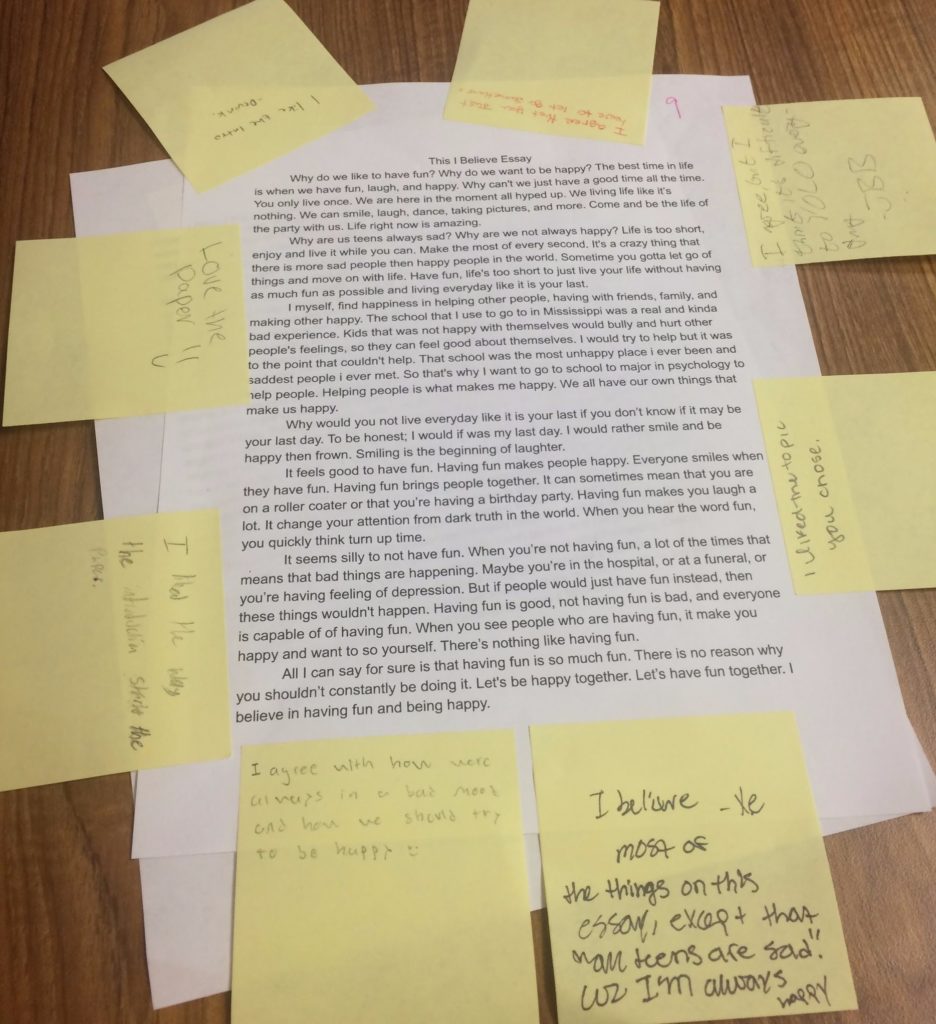
Overall, the feedback was uplifting and actually created a sense of belonging in each class. Students told me they learned so much about each other that day and were shocked by their classmates’ writing. A few said they wished they had written this essay sooner.
Sample Student Work
I was floored by some of the essays I received. Some made me laugh, some made me gasp, some made me cry. Compared to the typical papers I usually assign, this essay allowed my students to not just think about what they were writing but to care about their writing and to be intentional in the language they were using, both in word choice and rhetorical strategies, because it was about what they believe. It is some of the strongest student writing I have ever received as an English teacher.
Here are some sample paragraphs from students who gave me permission to share their work:
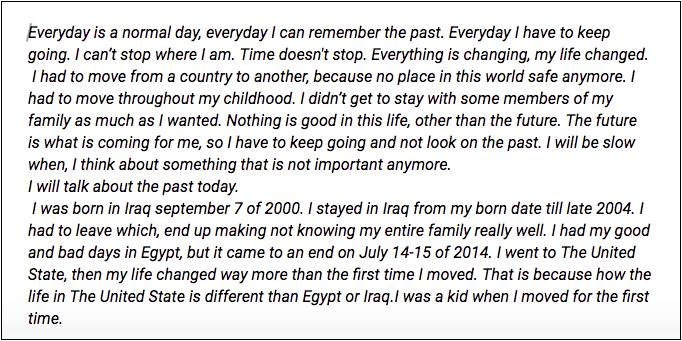
From a student who told me he hates school and hates writing.
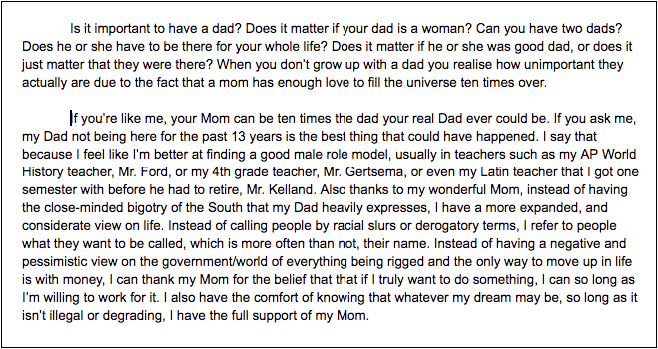
From a student who by all outward appearances, comes from a traditional family.
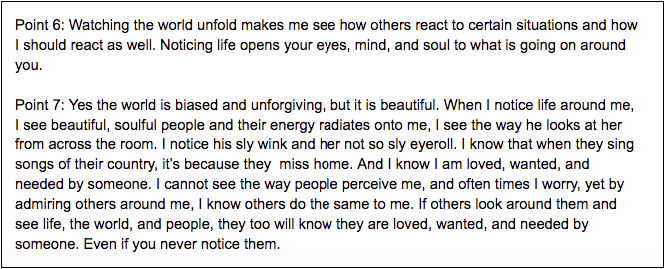
From a student battling depression and anxiety.
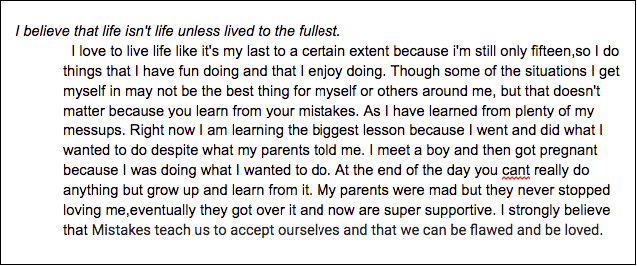
From a student who missed almost a whole semester but is trying to stay in school.
Although this essay helped end the year with a strong sense of community, I think teachers could easily have students write it at the beginning of the school year or even in January at the start of a new year. I’d love to hear how other teachers have used an essay like this in their classes. ♦
Have you taught a lesson or designed a learning experience we should feature in Power Lessons? Send a full description of your lesson through our contact form and we’ll check it out!
Join my mailing list and get weekly tips, tools, and inspiration—in quick, bite-sized packages—all geared toward making your teaching more effective and fun. You’ll also get access to my members-only library of free downloadable resources, including my e-booklet, 20 Ways to Cut Your Grading Time in Half, which has helped thousands of teachers spend less time grading!





Cynthia and Jennifer, Thank you for sharing this Power Lesson; it’s one I plan on “borrowing” for sure in January. I love the connection built during the gallery walk. I can imagine this being truly powerful for all students. Well done!
I LOVE this!! I will use this in the Spring with my students. The excerpts in the blog post were so personal. I hope the students realize what a gift they shared.
Tonya, I agree. I’m always so grateful when students are willing to let us see their work here!
I love this assignment. I use it every semester with Public Speaking students, following a similar brainstorm and drafting process. Since the assignment comes from a radio program, my students audio record themselves, and our celebration of the work happens through hearing each student read the essay. Very powerful hearing their voices!
Ruth, thanks so much for taking the time to share this idea. I’m sure lots of teachers will love how audio enriches this assignment.
Thank you for sharing the students’ samples. Writing is such a great way to express oneself and when you make it personal students are engaged. ❤️ it! I am thinking about adding it as my last assignment for my 3rd graders!
Thank you for sharing, especially the students’ work samples.This will help inspire my students to share important details about their lives.
Might I also recommend an excellent book I purchased used recently:
Reading, Writing and Rising Up (by Linda Christensen)
I like this writing strategy. Last week I started something similar with my Arabic students. In groups of 3 to 4 students, they wrote stories (Brainstorm, first draft…)
They started writing their final draft(with illustrations and drawings) on the butcher paper. On Monday, they will hang it on the wall and they will give each other feed back wile walking and reading each other’s essays.
The problem with the foreign languages students writing is that they have brilliant ideas in English, but they cannot express them in Arabic or French…
My questions is the following: Is there a way to adapt this writing strategy to World Languages students with taking into consideration the limited students’ language levels.
I love this assignment. I use at the end of the year with my seniors. I tell them to focus on a belief that they have formed over their past years of school and that will guide them as they make steps on their next journey — college, military, work, etc. Every year I am awed by the thought and pride they take in it. Their voices shine through the papers. The emotions, ranging from joy to sadness or humor to regret, overtake their essay making each both personal and universal. I also always write one that I individualize for each class and how they have shaped or firmed one of my own beliefs.
I love this, especially as a way to “re-enter” in January! I hope that I can use it effectively with my middle schoolers. Thank you so much for sharing this!
YES!! This was my first lesson in my first year of teaching and it completely set the tone for the rest of the year. The work I received from eleven year olds blew my mind, and I even submitted(with their permission) a few pieces to be published because they were that deep. Bravo to this I believe essays & sharing lessons like this with other educators.
Did you find that you had to add in any scaffolds/support for students? I want to try this with my 7th graders who really struggle with writing and getting started with ideas.
This looks like a fabulous project and one I am keen to try out next semester.
I, too, have been doing this assignment for a few years now. It is my favorite assignment of the year. I teach 8th grade English and I have my students share their essays aloud. We sit in a circle and listen to each student share his/her belief. It is powerful. We laugh. We cry. We learn. Having students write for an audience of their peers is challenging for them, but so rewarding in the end.
This looks great for January. I noticed that the This I Believe website has a high school curriculum for sale for $20. Has anyone used it? Is it worth it? Necessary?
This reminds me of an assignment I had in high school. It was called our “Capstone,” and was a year-long process (12th grade). We first chose three things that were important to our lives: a person, a place, and an event. Over the first semester we wrote about these in three separate papers. Then come second semester we had to connect them with a metaphor, and put together a 20 minute presentation that connected everything. It really allowed students to get creative while expressing what was most important to us.
Do you happen to have an example of this still? It sounds AWESOME and I would love to do it with my 8th graders!
Your students’ essays are beautiful, authentic and inspiring, as I am sure your teaching is. Thank you for sharing.
Thanks for the lesson. I like this idea for journaling too!
A brilliant idea! Thanks!
Thanks for sharing and including student work examples. Essays like this are a great way to get to know students at a deeper level and could also make a good college entrance essay!
Thank you for sharing this. Inspirational and heartfelt writing from young people.
This is so inspiring and beautiful. Thank you so much, both of you for sharing this power lesson. I was lookibng for a writing task muy ss could include in their e-Portafolio.
Can’t wait to try it!! Thank you again!!
I know this might be simplistic, but could you share more about the vocabulary devices?
Hi, April! For the vocabulary devices, I’m referring to adding similes, metaphors, hyperboles, imagery, etc. We usually practice devices like anaphora and asyndeton in my advanced classes, so those can also be used. One of my favorite lines this year was: “I mean, I thought a step stool would do the job but instead it was like climbing a 20 foot ladder just to finish my goal…” We talked about how using a vocab device is more powerful than “I worked really hard.” Hope that helps! Cheers!
This is sooooo great!! I love it!!!!!
I love this. Has anyone tried it at the start if the year? Are students willing to write about such personal experiences and beliefs with a teacher and classmates that they don’t know well?
Hi Lizzie! I work for Cult of Pedagogy, but I’m replying as a teacher. I teach college level freshman comp and I started my previous semester with this essay. Because it was the beginning of the year, I didn’t do a gallery walk; it was more of a practice assignment to get used to the flow of papers and feedback. They had to bring in a rough draft for in-class workshops, so I made sure they knew a few of their classmates would be reading what they wrote. For extra credit, I offered them the chance to record their paper as a “podcast” and post it on YouTube. I was blown away by how in-depth most of them went! In fact, I’m starting my fall semester with it again.
I love this assignment in the spring for senior English. Generally, kids are appreciative that we’re doing the final writing assignment about something that is ‘real world legit’. I’ve always been impressed by their level of attention (and attendance),as our gallery walk happens on the last day of their English class in June.
Hi!
This looks like a fantastic lesson and I would love to try it with one of my English classes. I noticed that your writing guidelines link is no longer available. Is there anyway I could get this information?
Thanks
Kelsey
Hi Kelsey!
Thanks for letting us know about the link. This was a guest post and we will be happy to reach out to Cynthia to see if she has a current link to the writing guidelines. If so, we’ll get that updated on the post as soon as we can. Thanks again!
I was wondering about the guidelines as well. I teach in China and we are out of school right now for Chinese New Year, so I would love to have this when we return in February. Thanks for your help!
Hi Karen & Kelsey!
I wanted to follow up on your request for the guidelines to let you know that Jenn no longer has access to them. If you haven’t already done so, Jenn recommends to check out the writing guidelines posted on NPR. I hope this helps!
I teach a course called Theory of Knowledge. One of the concepts we study is ‘faith’ as a way of knowing or gaining knowledge. I remember the “This I believe” series on the radio and then NPR. I have my students read several of the essays from the website and a few I copy from one of the books published. Then, they brainstorm and write their own essays. This spring, right before the Covid shutdown, one of my students committed suicide. I had returned his essay to him only days before; he’d written about the importance of love and relationships in life. Being able to share his essay with his mother and brother (who I had also taught) was a gift for all of us. I think the inspiration to have students write these essays was somehow a preparation for this sad experience.
I like the suggestions here and may use the sentence stems to help those who struggle to get started.
Hello! I want to say that I had some difficulties in writing essays and statements. When I entered college, the first thing I encountered was writing a quality application.
thanks for sharing, this is really useful information for me!
thanks for sharing
informative!
This looks like an amazing lesson plan and although it is late in the year I will try to use it. could you please send the grading rubric you used?
Hi, there! Because this post was written so long ago,we have unfortunately lost touch with the author, Cynthia Ruiz. From what we understand, she is no longer in the classroom. However, you may be able to connect with her on Twitter by clicking on the Twitter icon at the top of the post underneath Cynthia’s name.
If you are looking to create your own rubric, the section of this post called Assignment Guidelines links to the NPR website where Cynthia found the writing guidelines that she used as a basis for her own. In addition, there is another Cult of Pedagogy post on the single-point rubric, which you might find useful. I hope this helps!